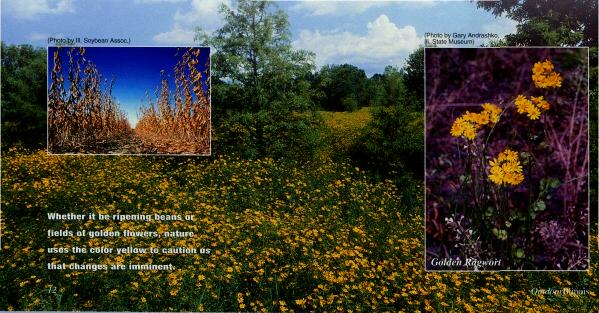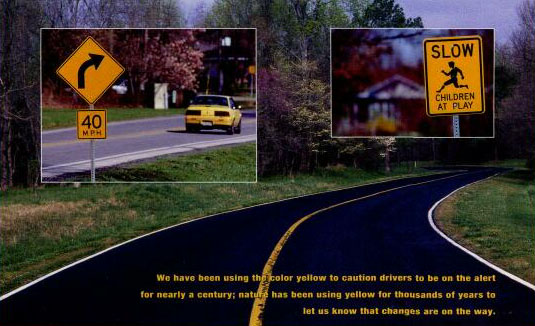|
Nature's Own Yellow Signs
The color yellow has a special significance.
BY BARRY HAIST
T' was an interesting day; one
in which I received the
answer to a question that I
had yet to ask myself. The answer:
"Because nature has always used it
that way." And the question that
came later: "Why was the color
yellow picked for 'caution signs'
that tell us changes lie ahead in our
man-made world?"
That color, yellow, captured my
attention as I was driving to one of
my favorite trails for an afternoon
in the woods. The bean fields I
passed were in the process of
changing from green to golden yellow. What a nice contrast, those big
rolling fields of yellow stretching
on to the deep-green tree lines.
But that sight has always meant
that big changes lie just ahead.
Another growing season is over.
Another summer gone. Time to
start thinking about shifting gears
and getting ready for the coming
changes induced by winter. Time to
be forced to slow down a bit.
As I drove on, my thoughts
turned back to other fields of golden
yellow that I had so enthusiastically
tromped through, just a few short
months ago. It was early spring
then, and for reasons known only to
nature, the giant golden ragwort
was everywhere. Fallow fields were
painted brilliant gold by the millions of dime-sized flowers of this
stalky plant. It was a spectacular
sight to behold as I walked along.
But after a few weeks of enjoying the giant ragwort, I remembered
how I became anxious for the other
colors of spring to show themselves. I wanted to see the reds, the
whites, the purples, and the blues.
One day, while trailing along a
field still golden with ragwort, I
recalled how I had abruptly come
to realize what I was doing. I was
trying to rush things.
"Slow down," I remember telling
myself. "The other colors will
come—just enjoy the day."


Or was it nature's yellow caution
sign—the flowing fields of golden
ragwort—that made me realize that
all of the changes of summer were
just ahead. I needed only to slow
down a little as they approached.
I puzzled over these strange
reflections that came out of
nowhere. As I drove along, I found
myself looking for yellow in the
natural world around me—a few
yellow leaves hidden here and there
among the trees and the yellow
blooms of the last flowering summer wildflowers along the ditches
of the roads and the edges of the
farm fields.
As I pulled into the parking area
near the trailhead, I wondered if I
would find any of nature's yellows
inside the still thickly greened
woods. I'd only gone a few yards
before I did—poison ivy. It covered
the forest floor as it always does,
but its three leaves now possessed
at least one, and sometimes two
yellow leaflets. And as I wandered
through the woods, I saw more yellow on the shrubby plants that
make up the forest's understory.
More of nature's "posted signs"
that subtly suggest that many
changes are to come. Soon the
temperatures will fall. Then the
leaves will turn and begin to cover
the ground instead of the trees.
By the time I finished this hike, I
was convinced that nature uses the
color yellow to remind us that she
has some major revisions in store
for us. And if we catch and heed
her gentle hints, we can get an
early start on preparing ourselves
for what lies ahead.
The human connection with the
color yellow came to me as soon as
I got back on the highway—the
yellow center line. Then came the
dozens of warning signs that I
passed: no passing; curve ahead;
school zone and intersection signs.
All urging me to be cautious and to
slow down in anticipation. And all
yellow—not blue, not red, not
green, but yellow.
That's when I asked myself
some questions for the first time:
"Why did yellow get picked to be
the color of all those caution signs?
Have we humans always had a
strong, subconscious connection
with nature buried somewhere deep
|
Barry Haist is an outdoor
columnist and pharmacist who
resides in Mattoon. His writing
appears in the Mattoon Journal
Gazette and the Charleston
Times-Courier.
|
within our souls? Have we always
known, without being told, that yellow is nature's way of telling us
that changes lie ahead? Perhaps.
And maybe today I just became
more aware of it.
A lot of springs have announced
their pending arrival with the
appearance of the first blooms in
near-frozen flower beds. Buttercups
and daffodils. Both yellow. And
this year I had their gentle hints of
pending change strongly reinforced
by the golden ragwort.
Mother Nature, it seems, uses the
color yellow in early spring to wake
us up from our own type of winter
slumber. And it looks like she uses
it in the late summer to gently
remind us that another winter soon
will be here. Perhaps this is her
quiet way of telling us to begin
making the necessary preparations
for the changes beyond the "yellow
caution signs" that she so courteously places all around us.
September 2001
|

